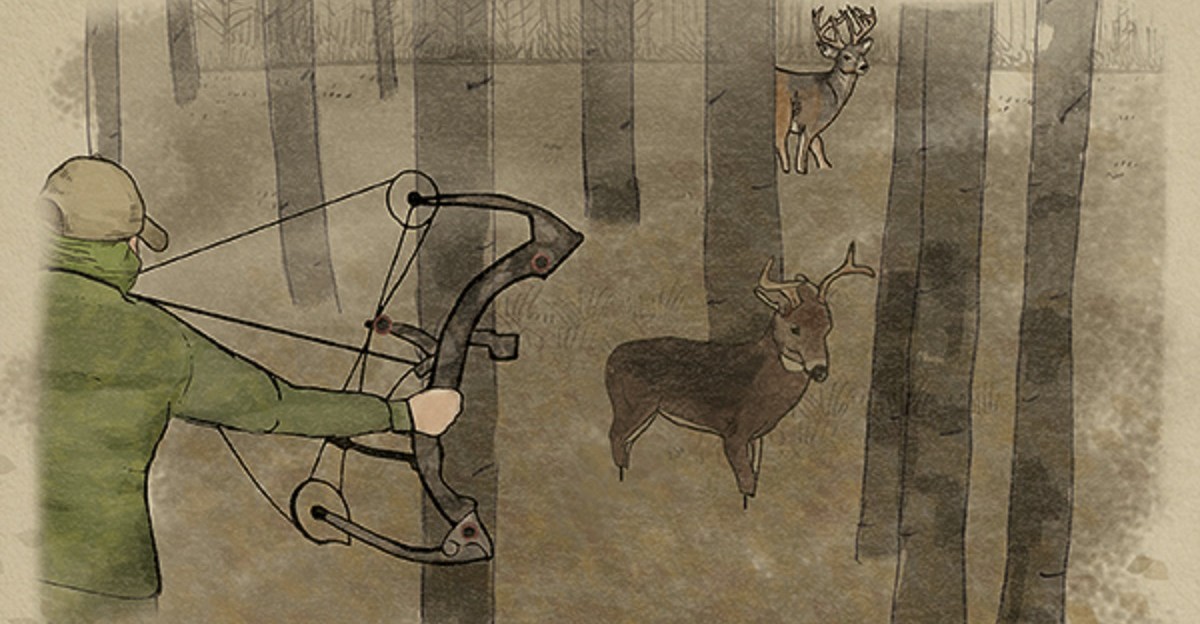To effectively use deer decoys throughout the rut, a hunter must match the setup to the emotional state of mature bucks. From mid-October to the end of November, bucks go through stages of aggression and breeding urges. This makes them vulnerable to a decoy. Knowing when and what decoy(s) to show the buck you are after is the name of the game.

Many times a hunter puts a doe decoy out in October, doesn’t get a reaction from a buck and loses faith in the power of decoys. But the hunter that tunes his or her decoy setups to the behavior and phase of the rut can capitalize on a deer’s vulnerable state and add even more excitement to the whitetail rut. Here are four setups that produce for me year after year. Are they guaranteed to work? No. No tactic during the rut ever is, but use decoys at the right time, and I bet you will pull a deer in close that would normally have passed by.
Early Rut
Scouting Report: Bucks have started to lay down sign regularly and tend scrapes and rubs. They are not roaming around too much, and are gobbling up acorns close to their bedding areas. Mature bucks are becoming restless as their aggression mounts and does are not yet ready to be courted.

Setup: Hunt the fringes of a buck’s core area or right over a primary scrape if you can get to it undetected. Wait for conditions to be perfect because, while the odds of tagging a buck in this scenario is very high, stand burnout is definitely a possibility if you are coming and going for multiple sits.
Once you’ve determined proper stand location for the wind, set up a single young buck decoy within bow range of your stand and quartering to you. Climb your stand and get ready with rattling antlers and a grunt tube. Tickle the antlers in a short sequence with just enough force to let the buck know there’s a trespasser messing around on his staked-out territory. Get ready to see antlers.
Why it works: Bucks are hoping for a reason to get up from their beds and they will usually jump at the chance to spar with an intruder. The rattling will put him on the prowl, but you may have to lead him to the decoy with a few grunts. Once he sees the decoy, stop calling and get ready to shoot. He will circle the buck decoy and approach head-on, offering you a broadside or quartering-away shot as he flanks the decoy.
The Chase Phase
Scouting Report: Tired of making scrapes and rubs, bucks will try to force themselves on does who are still not ready to breed in an act of frustration. This brief period of fast and furious buck movement occurs a week before the peak-breeding window.

Setup: While a single doe decoy will likely bring a stag buck into range, it may not pull a buck away from a doe he is already chasing. For insurance, against this scenario, I like to setup a Freshman buck decoy with Estrus Betty and watch bucks come unglued once they see a young deer about to hook up with a doe in estrus. Plus this setup keeps does from investigating the scene and blowing your cover. Place the decoys on a field edge, the top of intersecting ridges, clear-cuts and other areas where visibility is good and a buck will spot your decoy when you get his attention with some tending grunt and estrus bleat calls.
Why it Works: The decoy scene is likely to put the buck in a jealous rage. He’s dogging does with no success and suddenly sees an inferior buck with a doe in a breeding position. He will approach the buck first to chase it off or teach it a lesson, so keep this in mind when you are setting up for the best shot.
Peak-Rut
Scouting Report: Bucks are working overtime to meet up with as many receptive does as possible. A buck and a doe will be joined at the hip for a day or so until breeding takes place, then the buck is off to find another mate. They are generally sniffing around doe bedding and feeding areas and the trails, funnels and pinches that connect them.

The Setup: A standing buck decoy over a bedded doe decoy tells a roaming buck the doe is likely in estrus. Use a Dreamy Doe decoy. The head position and body angle are perfect for a bedded pose, so follow the instructions in this decoy setup guide to put her in a bedded position. Be sure to incorporate appropriate scents and calls to sell the act further.
Why it Works: Dominant bucks are not gentlemen this time of year and will quickly break up the love affair. The posturing pose of The Freshman buck decoy will issue a challenge to the real buck that he cannot refuse.
Post-Rut
Scouting Report: For the most part, the search for high-quality food sources is dictating deer movement, but there comes a time – usually around the end of November and beginning of December – when un-bred does come into estrus, causing a second rut.

The Setup: Keep competition out of the picture and set up Estrus Betty on the way to or on food sources. Throw down some estrus scent and use calls to tell a buck he has one last chance to breed. A buck will come to investigate the decoy from behind, so position the decoy quartering away slightly.

Why it Works: It’s hard for a buck to turn down such an easy breeding opportunity. The Estrus Betty, with her squatting pose, sends no mixed signals. She is not just another doe, but one that is looking for a mate.
This rut, pay attention to deer behavior and use your scouting information to set up a decoy scheme that will get a buck into bow range. The rut is a great time to see a lot of deer activity, but you are at the mercy of a lot of luck – hoping a doe will drag a buck past your stand. Get a mature buck – vulnerable with clouded judgment – to come to you this season. For more information on deer decoy setups and to buy the decoys mentioned here, please visit montanadecoy.com.







